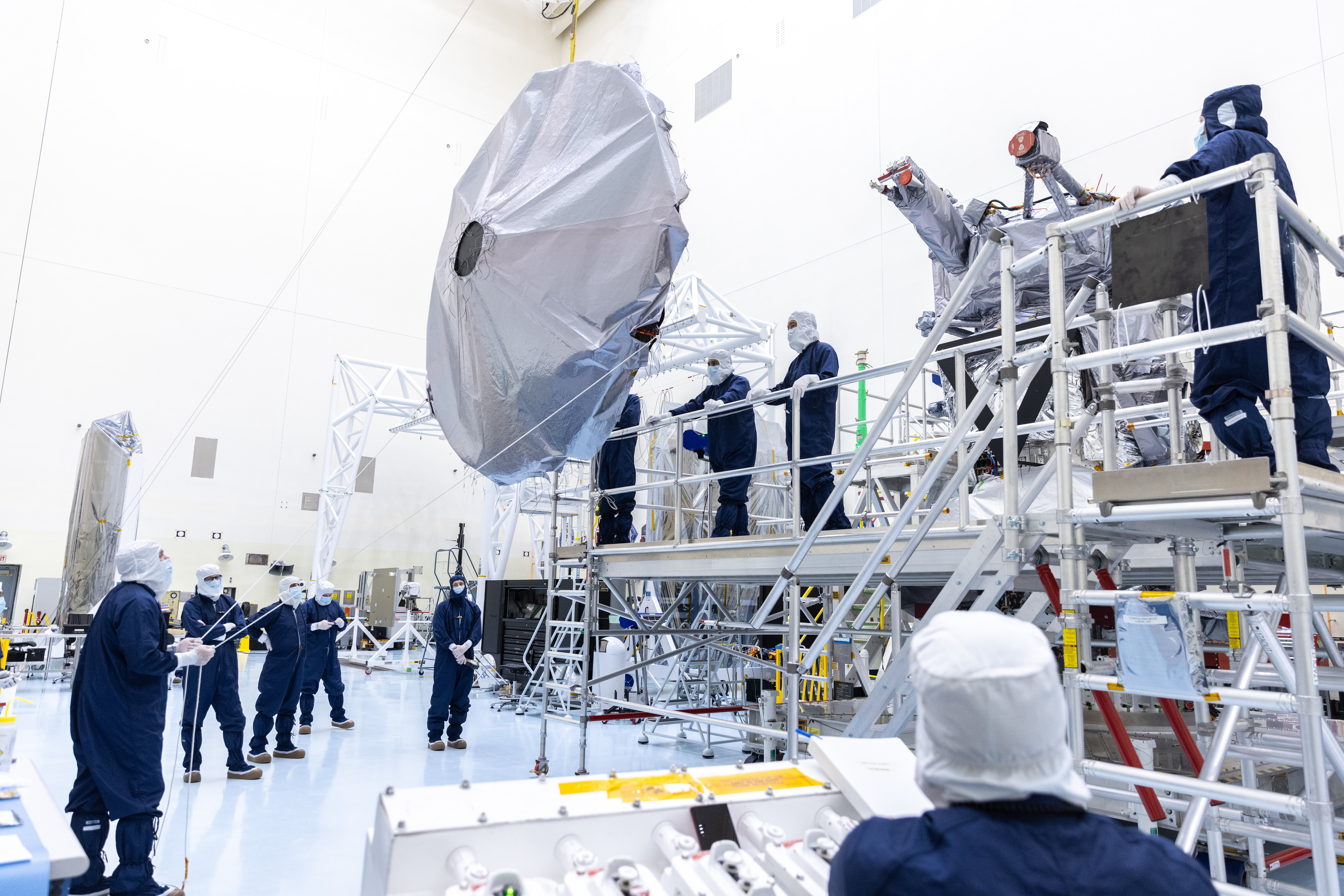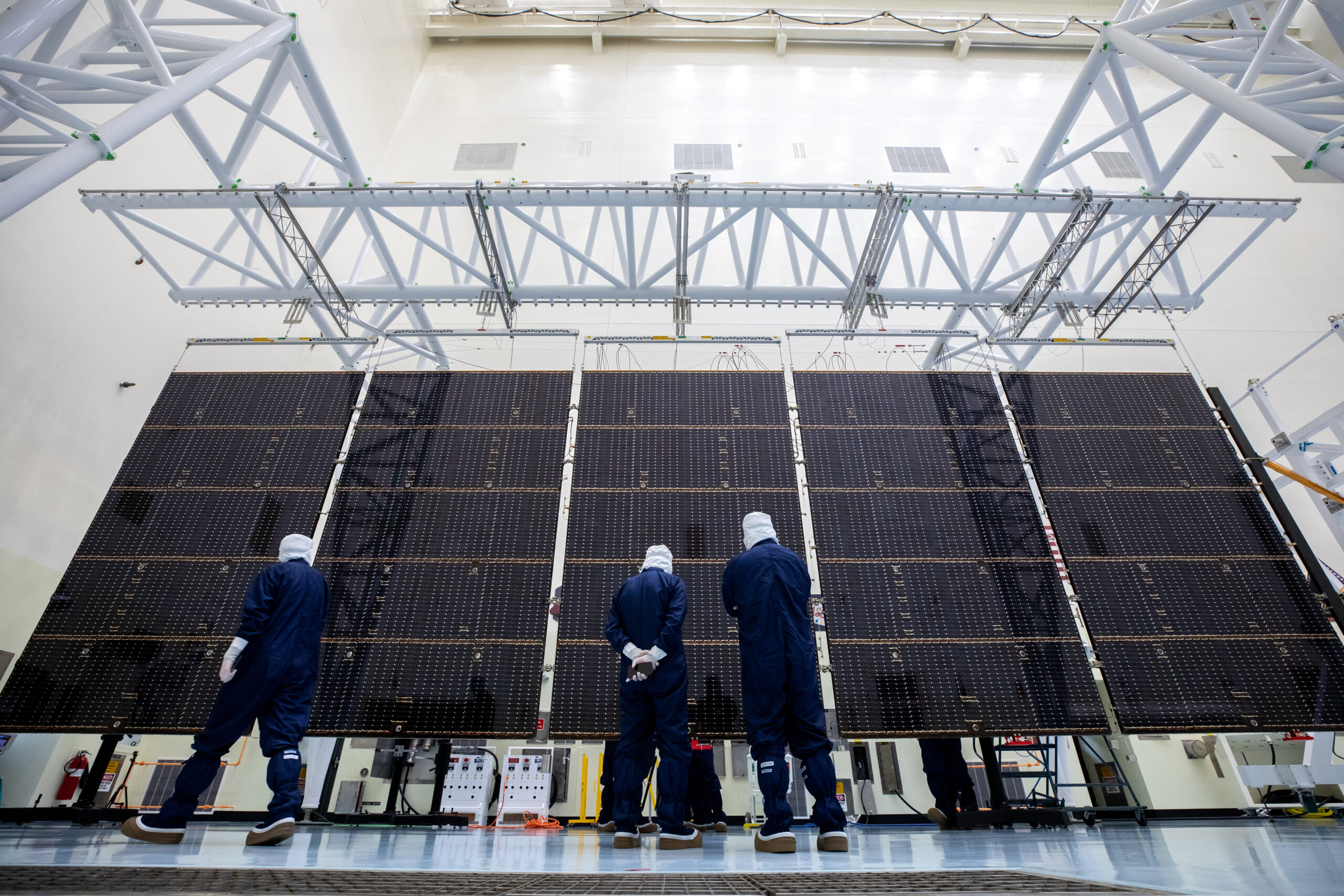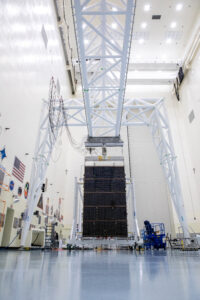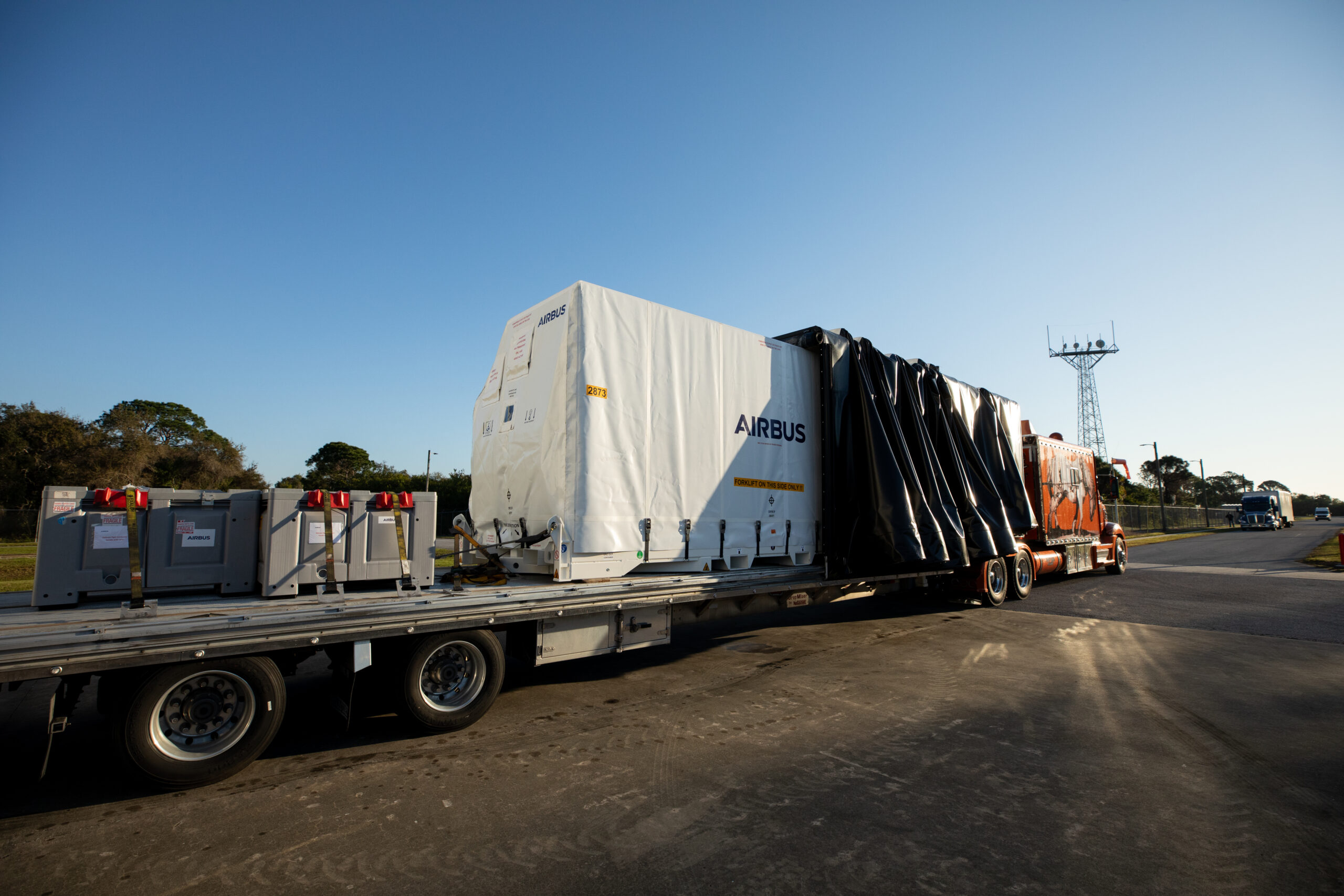NASA’s Europa Clipper mission passed a mission planning milestone, known as Key Decision Point E, on Monday. It now is approved to continue to proceed toward launch, with a launch period that opens Thursday, Oct. 10.
NASA’s Europa Clipper Mission Moving Toward October Launch Date
NASA’s Europa Clipper mission remains on track, with a launch period opening on Thursday, Oct. 10. The next major milestone for Clipper is Key Decision Point E on Monday, Sept. 9, in which the agency will decide whether the project is ready to proceed to launch and mission operations. NASA will provide more information at a mission overview and media briefing targeted for that same week.
The Europa Clipper mission team recently conducted extensive testing and analysis of transistors that help control the flow of electricity on the spacecraft. Analysis of the results suggests the transistors can support the baseline mission.
NASA Continues Assessing Electrical Switches on Europa Clipper
Launch preparations are progressing with NASA’s Europa Clipper mission. The spacecraft arrived at the agency’s Kennedy Space Center in Florida in May, where the team recently attached the high-gain antenna.
Engineers with NASA’s Europa Clipper mission continue to conduct extensive testing of transistors that help control the flow of electricity on the spacecraft. NASA’s Jet Propulsion Laboratory in Southern California, which manages the mission, began the tests after learning that some of these parts may not withstand the radiation of the Jupiter system, which is the most intense radiation environment in the solar system.
Tests also are being conducted at the Johns Hopkins Applied Physics Laboratory (APL) in Laurel, Maryland, and NASA’s Goddard Space Flight Center in Greenbelt, Maryland. APL designed the main spacecraft body in collaboration with JPL and NASA Goddard.
The issue with the transistors came to light in May when the mission team was advised that similar parts were failing at lower radiation doses than expected. In June 2024, an industry alert was sent out to notify users of this issue. The manufacturer is working with the mission team to support ongoing radiation test and analysis efforts in order to better understand the risk of using these parts on the Europa Clipper spacecraft.
Testing data obtained so far indicates some transistors are likely to fail in the high-radiation environment near Jupiter and its moon Europa because the parts are not as radiation resistant as expected. The team is working to determine how many transistors may be susceptible and how they will perform in-flight. NASA is evaluating options for maximizing the transistors’ longevity in the Jupiter system. A preliminary analysis is expected to be complete in late July.
Radiation-hardened electronics are used throughout industry to protect spacecraft from radiation damage that can occur in space. The Jupiter system is particularly harmful to spacecraft as its enormous magnetic field — 20,000 times stronger than Earth’s magnetic field — traps charged particles and accelerates them to very high energies, creating intense radiation that bombards Europa and other inner moons. It appears that the issue that may be impacting the transistors on Europa Clipper is a phenomenon that the industry wasn’t aware of and represents a newly identified gap in the industry standard radiation qualification of transistor wafer lots.
Europa Clipper’s launch period opens Oct. 10, and it is set to arrive at Jupiter in 2030, where it will conduct science investigations to understand the potential habitability of Europa as it flies by the moon multiple times.
NASA Installs High Gain Antenna for Mission to Study Icy Moon of Jupiter

When NASA’s Europa Clipper is in orbit around Jupiter, transmitting science data and receiving commands from Earth across hundreds of millions of miles, it will need a powerful antenna. Technicians installed the spacecraft’s high-gain antenna inside the Payload Hazardous Servicing Facility at NASA’s Kennedy Space Center in Florida on June 17.
Scheduled to launch later this year, Europa Clipper will embark on a 1.8-billion-mile (2.6-billion-kilometer) journey to Jupiter. It is the largest spacecraft NASA has developed for a planetary mission. Set to arrive in April 2030, it will study the gas giant’s icy moon, Europa, to determine its potential to support life.
The spacecraft will conduct approximately 50 flybys of Europa, allowing its nine science instruments to gather data on the moon’s atmosphere, its ice crust, and the ocean underneath. The nearly 10-feet-wide (3-meter) dish-shaped antenna and several smaller antennas will transmit the data to Earth, a trip that will take about 45 minutes when the spacecraft is in orbit around Jupiter.

To ensure Europa Clipper has the necessary bandwidth, the antenna will operate on NASA’s deep space X-band radio frequencies of 7.2 and 8.4 (GHz), and Ka-band at 32 (GHz), through the agency’s Deep Space Network, a global array of large radio antennas that communicate with dozens of spacecraft throughout the solar system.
Europa Clipper underscores NASA’s commitment to exploring our solar system for habitable conditions beyond Earth. Although Europa Clipper is not a life-detection mission, understanding Europa’s habitability will help us better understand how life developed on Earth and whether we’re likely to find conditions that might support life beyond our planet.
Technicians at NASA Kennedy will continue to prepare the spacecraft for its mission and perform final checkouts as part of launch preparations. Europa Clipper is scheduled to launch atop a SpaceX Falcon Heavy rocket from Kennedy’s Launch Complex 39A, no earlier than October 2024.
Europa Clipper’s high-gain antenna was designed by the Johns Hopkins University APL (Applied Physics Laboratory) in Laurel, Maryland, and aerospace vendor AASC (Applied Aerospace Structures Corporation) in Stockton, California.
Managed by Caltech in Pasadena, California, NASA’s Jet Propulsion Laboratory leads the development of the Europa Clipper mission in partnership with APL for NASA’s Science Mission Directorate in Washington. The main spacecraft body was designed by APL in collaboration with JPL and NASA’s Goddard Space Flight Center in Greenbelt, Maryland. The Planetary Missions Program Office at NASA’s Marshall Space Flight Center in Huntsville, Alabama, executes program management of the Europa Clipper mission.
NASA’s Launch Services Program, based at Kennedy, manages the launch service for the Europa Clipper spacecraft.
NASA Examines Electrical Switches on Europa Clipper Spacecraft
As NASA’s Europa Clipper continues preparations in advance of its launch period — opening Oct. 10 — the mission team is assessing whether transistors on the spacecraft can withstand the intense radiation the probe will encounter at Jupiter.
These transistors are used as electrical switches in many digital electronics. The particular versions used by Europa Clipper are radiation-hardened and are intended to tolerate 100 to 300 kilorad, or krad (a “rad” is a unit of measure for absorbed dose of ionizing radiation). However, the mission team at NASA’s Jet Propulsion Laboratory in Southern California, which manages the mission, is assessing test data that indicates some transistors could be affected by significantly lower radiation levels in some conditions.
The team is conducting more extensive testing to better characterize the transistor behavior and whether it may affect the functionality of the circuits on Europa Clipper. The agency has time to continue this work as the spacecraft proceeds toward its October launch period.
NASA’s Europa Clipper Makes Cross Country Flight to Florida

NASA’s Europa Clipper, a spacecraft designed to investigate Jupiter’s icy moon Europa and its potential to support life, arrived in Florida on May 23. The spacecraft, assembled at NASA’s Jet Propulsion Laboratory (JPL) in Southern California, landed aboard a United States Air Force C-17 Globemaster III aircraft at the Launch and Landing Facility at NASA’s Kennedy Space Center.
The mission aims to gather detailed measurements of the moon’s surface, interior, and space environment by performing approximately 50 close flybys, some as low as 16 miles from the surface of Europa, which holds a global ocean underneath its ice shell.

“My job for Europa Clipper is to ensure the team meets all the ground and flight requirements to place the spacecraft in the proper orbit to initiate the long journey to Jupiter,” said Armando Piloto, Europa Clipper mission manager for NASA’s Launch Services Program. “The team is excited that the spacecraft is in Florida for processing. We’re pairing Europa Clipper with a fully expendable SpaceX Falcon Heavy rocket to ensure it provides the required performance to explore a destination very far away from Earth.”
Teams at Kennedy spent several hours offloading Europa Clipper before transferring it to the Payload Hazardous Servicing Facility, where they will process the spacecraft and perform final checkouts as part of prelaunch preparations.
Europa Clipper joins the spacecraft’s two five-panel solar arrays that arrived at Kennedy in March. The arrays, each 46.5 feet long (14.2 meters), will collect enough sunlight to power the spacecraft on its way to Jupiter’s moon. Technicians will install the arrays on the spacecraft before launch.
The spacecraft was designed to withstand the pummeling of radiation from Jupiter and gather the measurements needed to investigate Europa’s surface, interior, and space environment.
Europa Clipper has nine dedicated science instruments, including cameras, spectrometers, a magnetometer, and an ice-penetrating radar. These instruments will study Europa’s icy shell, the ocean beneath, and the composition of the gases in the moon’s atmosphere and surface geology, and provide insights into the moon’s potential habitability. The spacecraft also will carry a thermal instrument to pinpoint locations of warmer ice and any possible eruptions of water vapor. Strong evidence shows the ocean beneath Europa’s crust is twice the volume of all the Earth’s oceans combined.
The Europa Clipper mission demonstrates NASA’s commitment to exploring our solar system and searching for habitability beyond Earth. The data will contribute to our understanding of the Jovian system and will help pave the way for potential future missions to study Europa and other potentially habitable worlds.
Europa Clipper is expected to reach the Jupiter system in April 2030, and it will accomplish a few milestones along the way, including a Mars flyby in February 2025 that will help propel the spacecraft toward Jupiter’s moon through a Mars-Earth gravity assist trajectory.

“After two years of painstaking work on the spacecraft here at JPL, with the help of our partners, it was bittersweet to see the spacecraft encased in its shipping container and on its way to Florida,” said Jordan Evans, Europa Clipper project manager at JPL. “But we already have Europa Clipper engineers and technicians at Kennedy who are welcoming this precious cargo and are set to accomplish the final assembly and testing so that we’re ready for launch.”
NASA and SpaceX are targeting launch aboard a Falcon Heavy rocket from Launch Complex 39A at Kennedy later this year. The launch period opens on Oct. 10. After testing and final preparations are complete, the spacecraft will be encapsulated in a protective payload fairing and moved to the SpaceX hangar at the launch complex.
Managed by Caltech in Pasadena, California, JPL leads the development of the Europa Clipper mission in partnership with the Johns Hopkins Applied Physics Laboratory (APL) in Laurel, Maryland, for NASA’s Science Mission Directorate in Washington. The main spacecraft body was designed by APL in collaboration with JPL and NASA’s Goddard Space Flight Center in Greenbelt, Maryland. The Planetary Missions Program Office at NASA’s Marshall Space Flight Center in Huntsville, Alabama, executes program management of the Europa Clipper mission.
NASA’s Launch Services Program, based at Kennedy, manages the launch service for the Europa Clipper spacecraft.
NASA’s Europa Clipper Mission Advances with Solar Array Deployment

Processing of the large solar arrays built for NASA’s Europa Clipper is now underway inside the Payload Hazardous Servicing Facility at the agency’s Kennedy Space Center in Florida.
Planned to arrive at Jupiter in April 2030, the spacecraft will study Jupiter’s moon Europa, which shows strong evidence beneath its icy crust of a global ocean over twice the volume of all Earth’s oceans. Europa is currently considered one of the most promising habitable environments in our solar system.

Once processing of the first five-panel solar array is complete, technicians will remove it from the gravity offload fixture, which helps support the weight of the array. The same steps will then be repeated with the second solar array. Built by Airbus in Leiden, Netherlands, the arrays arrived at Kennedy late last month by truck, after travelling to the U.S. by air.
When both solar arrays are installed and deployed on Europa Clipper – the agency’s largest spacecraft ever developed for a planetary mission – the spacecraft will span a total length of more than 100 feet and weigh 7,145 pounds without the inclusion of propellants. The spacecraft needs the large solar arrays to collect enough light to power it as it operates in the Jupiter system, which is more than five times as far from the Sun as Earth.
Europa Clipper is being assembled at NASA’s Jet Propulsion Laboratory in Southern California and is managed in partnership with Johns Hopkins University Applied Physics Laboratory in Laurel, Maryland. The spacecraft will ship to Florida later this year for launch aboard a SpaceX Falcon Heavy rocket from Kennedy’s Launch Complex 39A. NASA’s Launch Services Program, based at Kennedy, is managing the launch service.
Join the conversation and get Europa Clipper mission updates from these accounts:
X: @EuropaClipper, @NASA, @NASAJPL, @NASA_LSP, @NASASolarSystem, @NASAKennedy
Facebook: NASA’s Europa Clipper Mission, NASA, NASA Jet Propulsion Laboratory, NASA’s Launch Services Program, NASA Solar System Exploration, NASA’s Kennedy Space Center
Instagram: @NASA, @NASAJPL, @NASASolarSystem, @NASAKennedy
Europa Clipper Solar Arrays Arrive at NASA for Jupiter Moon Mission

NASA’s mission to study Jupiter’s icy moon Europa completed another milestone as power supply hardware for the Europa Clipper spacecraft arrived on Wednesday, Feb. 21, at the agency’s Kennedy Space Center in Florida.
Workers unloaded the five-panel solar arrays at the Payload Hazardous Servicing Facility. The solar arrays will attach to the spacecraft to power it on the 1.8-billion-mile journey to Europa. Strong evidence shows an ocean beneath Europa’s crust that is twice the volume of all the Earth’s oceans combined, and scientists want to determine if any areas can support life.

The solar array travelled by air from Leiden, Netherlands, where Airbus workers assembled them over the last year. Once at the Port of Miami in Florida, a truck transported the arrays to Kennedy.
The two solar arrays will collect enough sunlight for the spacecraft’s power needs as it operates in the Jupiter system, which is more than five times as far from the Sun as Earth. Each solar array is 46.5 feet long. With its solar arrays deployed, Europa Clipper spans more than 100 feet (about 30.5 meters), or about the length of a basketball court.
The spacecraft will perform dozens of close flybys of Europa to gather measurements of the internal ocean, map the surface composition and geology, and hunt for plumes of water vapor that might be venting from the icy crust.
Europa Clipper is the largest spacecraft NASA has ever developed for a planetary mission. It has nine dedicated science instruments, and the spacecraft’s electronics are enclosed in a vault made from aluminum-zinc alloy to protect them from intense radiation of Jupiter.
Europa Clipper is being assembled at NASA’s Jet Propulsion Lab (JPL) in Southern California and will travel to Kennedy early this summer. Launch is targeted for October 2024 aboard a SpaceX Falcon Heavy rocket from Launch Complex 39A, with a planned arrival at Jupiter in April 2030. NASA’s Launch Services Program, based at Kennedy, is managing the launch service.
